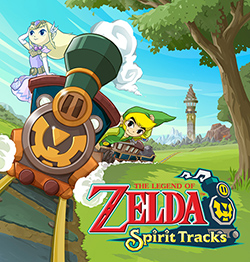912th played so far
Genre: Action/Adventure
Platform: Nintendo DS
Year of Release: 2009
Developer: Nintendo EAD
Publisher: Nintendo
Thanks to the Book of Mudora podcast, I’ve been steeped in Legend of Zelda lore recently – something that seems way deeper than the games justify, but it’s fun anyway. I’ve been waiting some of these out as well as the later entries in the series have really appealed to me – including Phantom Hourglass recently, which this game builds on. Then there’s the train angle – aside from the Railroad Tycoon planning segments, I feel there’s something similarly relaxing about those systems. You are constrained in where you go and what you do, and there can be something reassuring about that focus.
The two will come together in The Legend of Zelda: Spirit Tracks, and it feels almost immediately intuitive how the constraints of train transport could focus the world – you can unlock chunks by building new tracks and possibly build some puzzles around that. I’m not expecting miracles, but I am expecting something good here.
Our Thoughts
It feels like both this and Phantom Hourglass (as well as Wind Waker, although I’m struggling to remember that more) fundamentally change how you interest with the world in a Legend of Zelda game. The first game is defined by its large map and traveling and exploring it is a large part of the game, especially when you need to find the more hidden dungeons. The later games pull back on this a bit – Link to the Past is huge, but also have more content per screen while feeling like it has less of them – while the Nintendo 64 entries like Ocarina of Time have less of it as well.
Spirit Tracks completely divorces the concept of the overworld from the rest of gameplay as you travel along train tracks between towns and dungeons, fighting or scaring off enemies as you do but without the more complex mechanisms of the normal Zelda worlds. It means that opening new areas comes down to you laying or unlocking new tracks, which makes for a more organized experience that forces you down a funnel more but does make it clear when backtracking is needed, while the actual action segments are similarly delineated. Even aside from my interest in trains, it’s a really neat way to handle the world and it feels like a good way to set up the areas in the world without having to put in worldmap elements in between that’d be otherwise unnecessary – sure, it’s a good way to place collectibles, but they feel more organic here.
The dungeons and similar elements are pretty good – standard of the series at this point, but expanding on the control element that we had in Phantom Hourglass by having a ghost Zelda with you who can inhabit certain other creatures. It’s a neat twist on how to solve dungeons that pays off, while having a snarky Zelda present creates its own view on the world and the continuing commentary works well. The combat is still awkward and the graphics seem a bit blocky for the DS, but on the whole they’re really interesting to reach and go through, and not always as unfair as other games can be.
There’s just one thing though – there’s a terrible stealth section at the start, that relies on you drawing a path for Zelda to follow. While it partially pays off later on with controls, here it’s so awkward that it got in the way – especially considering you didn’t get to see most of the actually fun features of the game. Stealth sections in games not designed for it just don’t work a lot of the time (another reason why I still haven’t beaten that final beast in Breath of the Wild).
Final Thoughts
Sure, Legend of Zelda: Spirit Tracks would always grab me, and more than other fans of the series would do. The 2D iterations of Zelda are my favourite, over the 3D iterations, and I think this game is using all of that to the maximum effect. Sure, there are bits that are gimmicky – that’s what seems to happen to these long-running franchises – but I enjoyed how it did all of it here.
